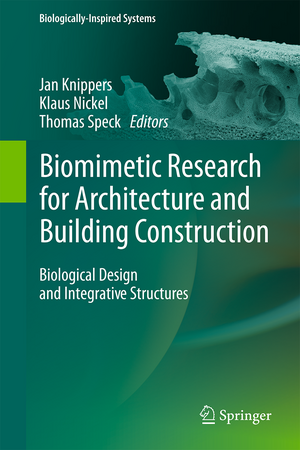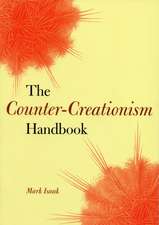Biomimetic Research for Architecture and Building Construction: Biological Design and Integrative Structures: Biologically-Inspired Systems, cartea 8
Editat de Jan Knippers, Klaus G. Nickel, Thomas Specken Limba Engleză Hardback – 27 dec 2016
| Toate formatele și edițiile | Preț | Express |
|---|---|---|
| Paperback (1) | 1197.14 lei 38-45 zile | |
| Springer International Publishing – 7 iul 2018 | 1197.14 lei 38-45 zile | |
| Hardback (1) | 1219.33 lei 38-45 zile | |
| Springer International Publishing – 27 dec 2016 | 1219.33 lei 38-45 zile |
Preț: 1219.33 lei
Preț vechi: 1604.39 lei
-24% Nou
Puncte Express: 1829
Preț estimativ în valută:
233.33€ • 249.50$ • 194.54£
233.33€ • 249.50$ • 194.54£
Carte tipărită la comandă
Livrare economică 14-21 aprilie
Preluare comenzi: 021 569.72.76
Specificații
ISBN-13: 9783319463728
ISBN-10: 3319463721
Pagini: 463
Ilustrații: XIII, 408 p. 197 illus., 115 illus. in color.
Dimensiuni: 155 x 235 x 25 mm
Greutate: 0.95 kg
Ediția:1st ed. 2016
Editura: Springer International Publishing
Colecția Springer
Seria Biologically-Inspired Systems
Locul publicării:Cham, Switzerland
ISBN-10: 3319463721
Pagini: 463
Ilustrații: XIII, 408 p. 197 illus., 115 illus. in color.
Dimensiuni: 155 x 235 x 25 mm
Greutate: 0.95 kg
Ediția:1st ed. 2016
Editura: Springer International Publishing
Colecția Springer
Seria Biologically-Inspired Systems
Locul publicării:Cham, Switzerland
Cuprins
1. Biomimetic Research: a Dialogue Between the Disciplines.- 2. From Minimal Surfaces to Integrative Structures – The SFB-TRR 141 in the Light of the Legacy of Frei Otto and the SFB 230 ‘Natürliche Konstruktionen’.- 3. Bionics and Biodiversity – Bio-inspired Technical Innovation for a Sustainable Future.- 4. Insect-Inspired Architecture – Insects and other arthropods as a source for creative design in architecture.- 5. In Search of some Principles of Bio-Mimetics in Structural Engineering.- 6. Fundamentals of Heat and Mass Transport in Frost-Resistant Plant Tissues.- 7. Plants and Animals as Source of Inspiration for Energy Dissipation in Load Bearing Systems and Facades.- 8. Adaptive Stiffness and Joint-Free Kinematics – Actively Actuated Rod-Shaped Structures in Plants and Animals and their Biomimetic Potential in Architecture and Engineering.- 9. Compliant Mechanisms in Plants and Architecture.- 10. Branched Structures in Plants and Architecture.- 11. The Skeleton of the Sand Dollar as a Biological Role Model for Segmented Shells in Building Construction: a Research Review .- 12. Continuous Fused Deposition Modelling of Architectural Envelopes Based on the Shell Formation of Molluscs: a Research Review.- 13. Analysis of Physcomitrella Chloroplasts to Reveal Adaption Principles Leading to Structural Stability at the Nano-Scale.- 14.Developing the Experimental Basis for an Evaluation of Scaling Properties of Brittle and "Quasi-Brittle" Biological Materials.- 15.Evolutionary Processes as Models for Exploratory Design.- 16.Fabrication of Biomimetic and Biologically Inspired (Modular) Structures for Use in the Construction Industrie.- 17. Structural Design with Biological Methods: Optimality, Multi-Functionality and Robustness.- 18. Bio-Inspired Sustainability Assessment – a Conceptual Framework.- 19.Making Life “Visible”: Organism Concepts in Biology and Architecture as the Basis for an Interdisciplinary Synopsis of Constructional Biomimetics.- 20. Perceptual Orientation and Spatial Navigation in Dense Urban Environments
Notă biografică
Jan Knippers (corresponding editor), University of Stuttgart, Stuttgart, Germany
Klaus G. Nickel, University of Tübingen, Tübingen, Germany
Thomas Speck, University of Freiburg, Freiburg, Germany
Textul de pe ultima copertă
This book comprises a first survey of the Collaborative Research Center SFB-TRR 141 ‘Biological Design and Integrative Structures – Analysis, Simulation and Implementation in Architecture’, funded by the Deutsche Forschungsgemeinschaft since October 2014. The SFB-TRR 141 provides a collaborative framework for architects and engineers from the University of Stuttgart, biologists and physicists from the University of Freiburg and geoscientists and evolutionary biologists from the University of Tübingen. The programm is conceptualized as a dialogue between the disciplines and is based on the belief that that biomimetic research has the potential to lead everyone involved to new findings far beyond his individual reach. During the last few decades, computational methods have been introduced into all fields of science and technology. In architecture, they enable the geometric differentiation of building components and allow the fabrication of porous or fibre-based materials with locally adjusted physical and chemical properties. Recent developments in simulation technologies focus on multi-scale models and the interplay of mechanical phenomena at various hierarchical levels. In the natural sciences, a multitude of quantitative methods covering diverse hierarchical levels have been introduced. These advances in computational methods have opened a new era in biomimetics: local differentiation at various scales, the main feature of natural constructions, can for the first time not only be analysed, but to a certain extent also be transferred to building construction. Computational methodologies enable the direct exchange of information between fields of science that, until now, have been widely separated. As a result they lead to a new approach to biomimetic research, which, hopefully, contributes to a more sustainable development in architecture and building construction.
Caracteristici
on is also of general interest for the public and in politics To sum up: With bio-inspired and the potential for more sustainable architecture and construction technologies the book meets some of the most urgent problems in a world with increasing population that more and more accumulates in megacities and deceasing resources There does no comparable book exist dealing with bio-inspired construction technology and architecture in the depth and width as this book The authors of the book chapters are worldwide renown specialists in their respective field of research and their interdisciplinary cooperation in the various research projects will cause wide interest ranging significantly over the field of bio-inspired construction technology and architecture Bio-inspiration in technology and architecture is of more and more increasing interest as well in research as in application and represents one of the most discussed and fascinating topics as well in translational biology as in architecture and construction technology The “biomimetic promise”, i.e. biomimetic solutions have an especially high potential to be sustainable and ecologically friendly solutions is a widely accepted idea and will be discussed for the first time in detail in some of the chapters of this book. This discussi

























